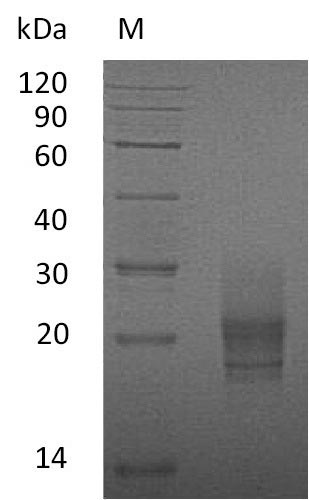Recombinant Mouse Granulocyte-macrophage colony-stimulating factor (Csf2) is produced in a mammalian cell expression system, which appears to ensure proper protein folding and post-translational modifications. The protein comprises the full length of the mature form, spanning amino acids 18 to 141, and is tagged with a C-terminal 6xHis-tag for ease of purification. With a purity greater than 95% as determined by SDS-PAGE, this product exhibits biological activity, evidenced by an ED50 of 40-170 pg/ml in a cell proliferation assay using PDC-P1 cells. Endotoxin levels are maintained below 1.0 EU/µg as determined by the LAL method.
Granulocyte-macrophage colony-stimulating factor (GM-CSF), also called CSF2, represents a crucial cytokine involved in hematopoiesis. It's particularly important in the differentiation and proliferation of granulocyte and macrophage progenitor cells. GM-CSF also plays a significant role in immune responses and inflammation by modulating leukocyte functions. Given these properties, GM-CSF has become a protein of considerable interest in research exploring immune system regulation, inflammatory diseases, and potential therapeutic applications.
Potential Applications
Note: The applications listed below are based on what we know about this protein's biological functions, published research, and experience from experts in the field. However, we haven't fully tested all of these applications ourselves yet. We'd recommend running some preliminary tests first to make sure they work for your specific research goals.
1. Cell Proliferation and Viability Assays for Hematopoietic Research
This recombinant GM-CSF is highly potent (ED₅₀ 40-170 pg/ml) and suitable for proliferation assays in hematopoietic cells. However, researchers should validate activity in primary mouse bone marrow cells or other relevant cell types, as sensitivity may vary based on GM-CSF receptor expression. The His-tag is unlikely to significantly impact proliferation readouts, but dose-response curves should be established for each cell type to account for potential differences in kinetics or potency.
2. Cytokine Receptor Binding and Signaling Studies
The biologically active GM-CSF is appropriate for receptor binding and signaling studies, but the C-terminal His-tag may sterically hinder interactions with the GM-CSF receptor complex (GM-CSFRα/βc/βc), potentially altering binding kinetics or signaling amplitude. Researchers should validate key findings with tag-free GM-CSF or include controls to account for tag-related artifacts. The mammalian expression ensures native-like PTMs, supporting reliable pathway analysis (e.g., JAK-STAT activation).
3. Antibody Development and Validation
This mammalian-expressed GM-CSF serves as a good antigen due to proper folding, but the His-tag may induce tag-specific antibodies, leading to poor recognition of native, tag-free GM-CSF. Antibodies should be validated against tag-free GM-CSF or native protein from biological sources to ensure specificity. The high potency supports functional neutralization assays, but cross-reactivity with other cytokines should be tested.
4. Comparative Species-Specific Cytokine Studies
The mouse-specific GM-CSF enables valid comparative studies, but the His-tag may confound direct activity comparisons with untagged GM-CSF from other species. Researchers should include parallel assays with tag-free variants or use normalized activity units (e.g., IU/ml) to account for potential tag-related differences in potency or receptor affinity.
5. Protein-Protein Interaction and Pull-Down Assays
The His-tag facilitates pull-down assays, but it may cause non-specific binding or mask interaction sites near the C-terminus. Researchers should use stringent controls (e.g., tag-only controls) and validate identified interactions with tag-free GM-CSF or alternative methods (e.g., co-IP). The high purity minimizes contaminants, but the tag may affect interactions with receptors or other partners.
Final Recommendation & Action Plan
This mammalian-expressed mouse GM-CSF is a high-quality reagent with exceptional potency, making it suitable for most proposed applications. However, the C-terminal His-tag requires careful consideration. For immediate use, employ it at picogram-level concentrations (10-200 pg/ml) based on the ED₅₀, but establish dose-response curves for each specific cell type or assay. For binding and interaction studies, validate key results with tag-free GM-CSF to ensure physiological relevance. When developing antibodies, use this protein for immunization, but screen for tag-independent specificity. For comparative studies, normalize activities to account for tag effects. The mammalian expression ensures proper PTMs, but critical findings should be confirmed with native GM-CSF when possible. Always include appropriate controls (e.g., vehicle, tag-only) to minimize artifacts.






